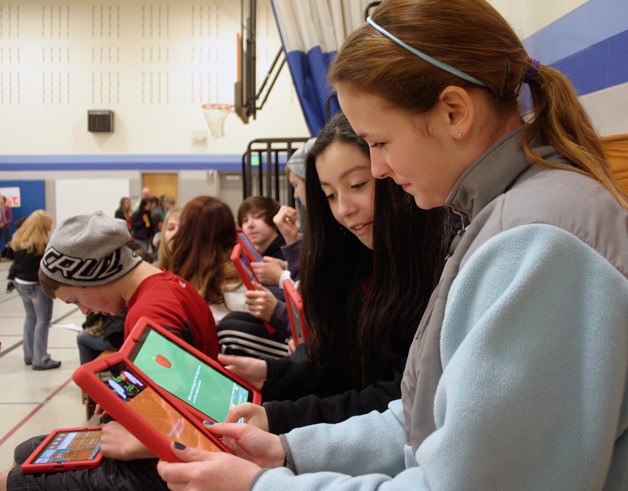LANGLEY — Swiping fingers with faces angled down showed the story of education’s future on South Whidbey.
All of Langley Middle School’s 120 seventh-grade students demonstrated their iPads during an open house Thursday afternoon. Parents, school board members and others filtered through the school’s cafeteria and gym where stations were set up for the seventh graders to show how they use the publicly funded tablets to learn math, science, English, social studies and health. Yes, even health is being taught with an iPad.
“There’s a lot of blood types, but any type of O-blood can transfer their blood to anyone,” said a slightly flustered Kayla Gardner when asked to recall something she learned from an iPad health app.
Interactivity and tactile sense are what makes the iPads effective teaching tools.
“You’re learning but you’re having fun,” said Ocean Benz, who manned the math table.
“It’s a more engaging experience,” added Lance Broce.
Somewhere, Steve Jobs is smiling.
South Whidbey rolled out its iPad program at the start of the school year. The 2012/2013 school district budget had $83,510 for iPads at the middle school and the K-12 alternative program at South Whidbey Academy, $28,100 for teachers’ iPads and $44,427 for the district’s technology director, David Pfeiffer. After years of planning and accruing capital/technology levy dollars, students powered on the tablets in October.
Three months later and students had a chance to show their parents geography, math problem, physiology and molecule structure apps. Presentations will soon move to the tablets, too, as students learn to use Apple TV to project lessons, worksheets and images in front of the class. And what if an answer is wrong when a teacher projects a student’s screen to their peers?
“Then that would be horrible,” said Xavier O’neill.
Teachers and the school’s principal, Eric Nerison, have plans to eventually let students pack the iPads home. But first, the seventh graders had to prove it through a “driver’s license” period that established responsibility. Downloading apps without school authorization, for example, counts against students.
But that doesn’t mean kids can’t have fun with the expensive tool-toys. Lance Broce and Jovani Thomas laughed at the math table while solving fraction addition questions on the Rocket Math app. While the work does not end up being graded by teachers, the lessons stick with kids. Solving equations on an iPad provides instant feedback on the answer, and one app requires students to prove a wrong answer when determining if fractions are greater than, less than or equal to each other. Rather than waiting for a teacher to check their work or looking in the back of a math textbook to see the correct answer, students can be prodded to see the valuation, in all its sound and color, thank to the iPad.
Instead of a binder full of worksheets and a backpack loaded with books, kids tote around a 1.5 pound tablet loaded with quiz apps for everything from skeletal structure to vocabulary.
The school district is seeking two levies, one for maintenance and operations, one for capital/technology. The capital/technology levy was proposed for $2 million annually, more than doubling, for the next six years.
Most of the money would pay for building repairs, but the same amount of $750,000 would be reserved for the technology fund that pays for computers, tech support and part of the Pfeiffer’s salary.



